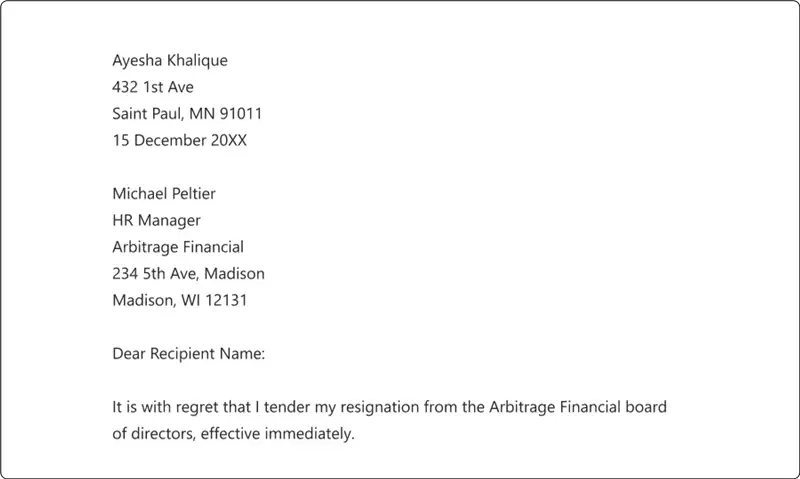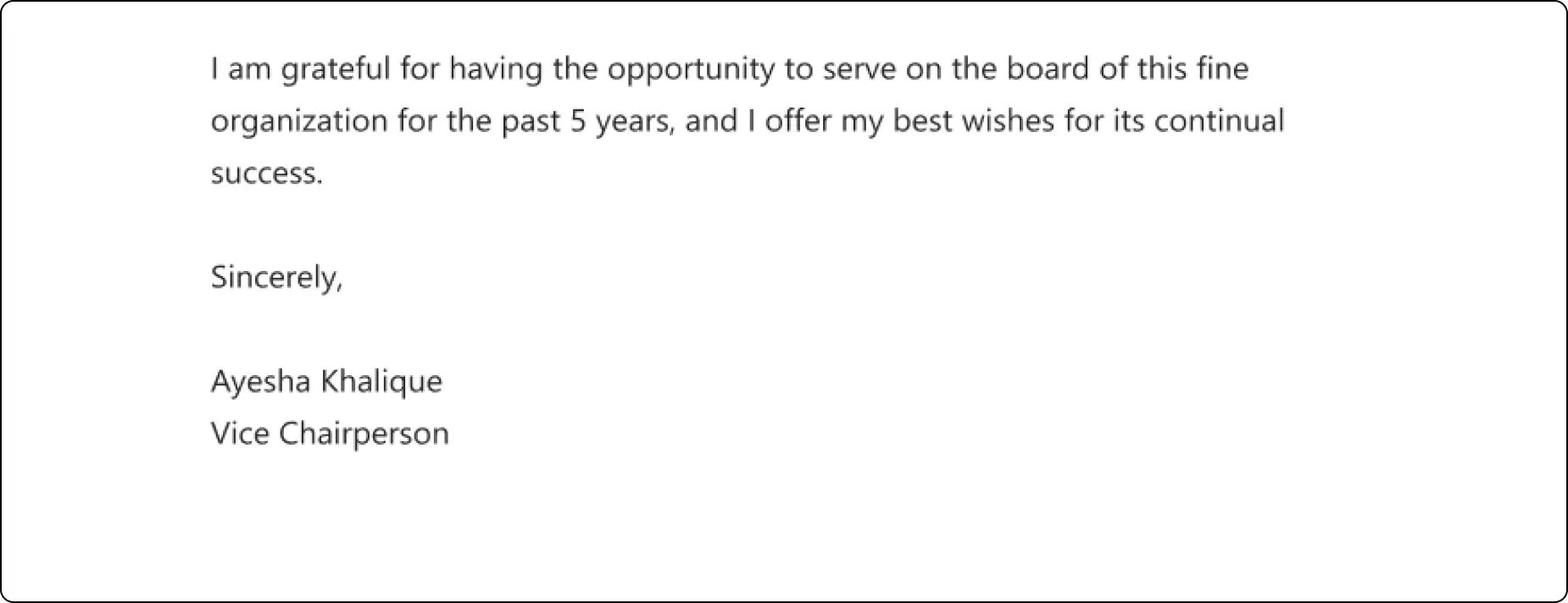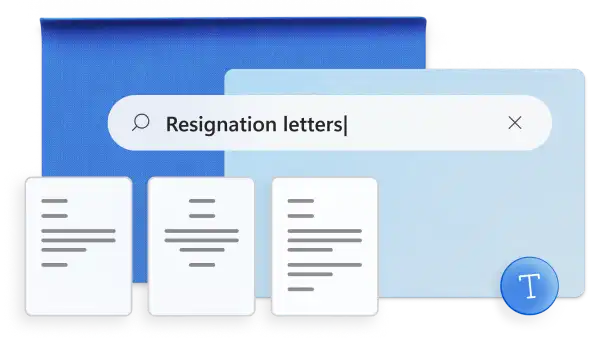On this page
Looking to resign from your current position, but unsure how to break your news of departure? Instead of telling your manager “I quit!”, you could create a gracious letter of resignation to professionally express why and when you’d like to leave your current position.
A resignation letter is a formal document either printed or emailed that’s ideally shared with two weeks' notice. A professional letter of resignation can help you maintain a respectful rapport for the rest of your time at the company.
No matter what industry you’re resigning from, we’ve created a helpful guide to assist you in writing an effective resignation letter from start to finish. Learn how to create a formal document from scratch or start with a ready-to-use resignation letter template by Microsoft Word.
How to format a resignation letter
Resignation letter outline
Let’s look at what to include in your resignation letter below.
Date and salutation: state the date of when you are writing the document and who the resignation letter is addressed to. Share the full name or first name of your employer.
Statement of resignation: respectfully share why you’re writing the resignation letter, with a top-level reasoning for leaving your current role.
Last day of work: specify when your last working day is in line with your notice period obligations.
Statement of gratitude: share gratitude to your employer for all the opportunities the companies provided you. For example, give thanks for work related experiences, learnings, professional relationships, and mentorships.
Next steps and transition details: provide an insight and details on what the next steps look like for yourself and a proposed transition post departure.
Professional sign off: finish your resignation letter with "kind regards", "sincerely", or "thank you", then sign off with your full name.
Resignation letter formatting guidelines
Here are a few elements you should include when writing a resignation letter:
Use a clear font and size
If you’re typing your letter of resignation, the font you choose can represent your professionalism. The experts at Microsoft Word recommend selecting size 12 – 14 in Calibri, Aptos, or Arial fonts, as they’re a great fit for any industry while being accessible and extremely easy to read.
Use correct spacing and margins
Write your letter of resignation inside Word using the automatic margin "normal". The automatic margin leaves one inch at the top, bottom, and sides of your page. Make sure your line spacing is either 1 or 1.5 to avoid text becoming too lengthy.
Keep to a one-page length
Like a recommendation letter, keep your resignation letter to a one-page limit. Make sure it’s brief and only includes necessary details.
Apply spell checks and proofread
Before saving and sharing your resignation letter, make sure there are no spelling, formatting, or punctuation errors. To proofread your document, try out the Microsoft Editor checker. Microsoft Word lets you easily refine the clarity and formality of your letter while simultaneously checking spelling and grammar.
Export in the correct file format
Word autosaves your resignation letter as you write, so there’s no need to save as you go. When you’re ready to export your document, download it as a PDF for free. You can also print your document from directly inside Word.
Name your resignation letter
If you save your resignation letter to your device or share it via a link or email, be sure to rename your document appropriately so your HR department can easily identify your letter. For example, yourname_resignationletter_date.
What not to include in a letter of resignation
Have you included one of the following in your resignation letter? It’s important to know what not to include to stay professional.
Sensitive career or future details: don’t share any detailed information or descriptions about new salaries and benefits of your next job position or role.
Unprofessional language: never use any profanities or disrespectful language within your resignation letter. All negative emotional attachments should be omitted from your document.
Detailed reason for resigning: even though you should share a brief reason for leaving your current role, it’s not required to share any details or specifics with your employer. If you would like to share more details, schedule an exit interview or meeting with your manager privately.
Criticism towards co-workers: your resignation letter should never include criticism towards other individuals, co-workers, or peers within the company.
How to write a resignation letter in Word
Easily write a resignation letter from start to finish in Microsoft Word. If you don’t want to write from scratch, select an industry specific resignation letter template that includes all of the required outline and formatting.
Write a resignation letter with a template
Open Microsoft Word on your device.
Search resignation letter in the search bar then click on the templates option.
Click on a resignation letter template to begin.
Customize the template with your personal information.
Proofread your document with Microsoft Editor or enhance copy with Microsoft Copilot. If you don't have a Microsoft 365 subscription, you can still leverage the power of Copilot at copilot.microsoft.com.
Export as a PDF for easy sharing.
Write a resignation letter from scratch
Open Microsoft Word on your device.
Create a new document.
Type your resignation letter in the correct format.
Proofread your document with Microsoft Editor or enhance copy with Microsoft Copilot.
Export as a PDF for easy sharing.
Resignation letter examples
Whether you’re looking for a colorful and friendly example or a basic black and white resignation letter, explore popular Microsoft Word templates to suit any need.
Modern resignation letter
Use this resignation letter sample if you’re wanting to express your appreciation and wish your old employer well in a few sentences. The simplistic design and minimalistic approach makes your letter clear, accessible, and straightforward. Just customize the template by replacing the text.
Letter of resignation from board
Give a written notice of your resignation from an organization or non-profit board with this letter of resignation template. The example letter of resignation template expresses appreciation for the opportunity to serve and wishes the organization well.
Browse all resignation letter templates designed for teachers, IT professionals, and individuals announcing retirement in Word. Each example includes essential formatting such as the date, salutations, and last working day, making it easy for you to personalize and share.
Start creating a resignation letter to share with your manager, employer, or HR department today with free templates by Word.
Need help with your new job search? Take a look at how to write a quality cover letter.
Frequently asked questions
When should I write a letter of resignation?
You should write your resignation letter after deciding you’d like to leave your current job. Submit your letter to your employer typically with two weeks' notice.
How should I submit a resignation letter?
After exporting your letter of resignation from Microsoft Word as a PDF, you can send via any platform you use for work. Sharing a resignation letter via an email attachment to your employer, manager, or HR department is preferred.
What should my resignation email’s subject line say?
When sharing your resignation letter via email, it’s best to keep the subject line direct and concise. Simply add ‘resignation’ to the subject line or ‘notice of resignation.’






